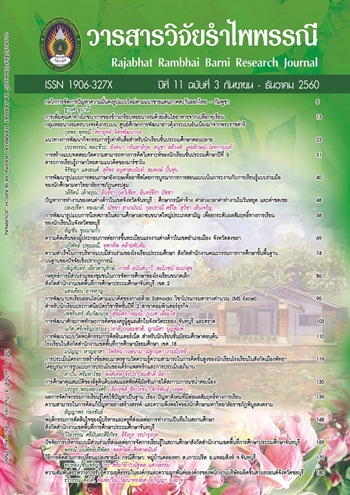การพัฒนารูปแบบการสอนภาษาอังกฤษเพื่ออาชีพโดยการบูรณาการการสอนแบบเน้นภาระงานกับการเรียนรู้แบบร่วมมือ ของนักศึกษามหาวิทยาลัยราชภัฏนครปฐม
Main Article Content
บทคัดย่อ
การวิจัยครั้งนี้มีจุดมุ่งหมายเพื่อพัฒนาและเปรียบเทียบรูปแบบการสอนภาษาอังกฤษเพื่ออาชีพโดย บูรณาการการสอนแบบเน้นภาระงานกับการเรียนรู้แบบร่วมมือในการเรียนภาษาอังกฤษของนักศึกษาสาขาวิชาการพัฒนาชุมชน มหาวิทยาลัยราชภัฏนครปฐม ที่เรียนวิชาภาษาอังกฤษเพื่ออาชีพ ในภาคเรียนที่ 2 ปีการศึกษา 2558 จำนวน 26 คน เครื่องมือที่ใช้ในการวิจัยประกอบด้วย 1) แผนการจัดการเรียนการสอนที่เน้นการสอนภาระงานและการเรียนรู้แบบร่วมมือ 2) แบบทดสอบก่อนเรียน และหลังเรียน โดยเนื้อหาข้อสอบเป็นแบบทดสอบปรนัย และอัตนัย 3) แบบประเมินความพึงพอใจต่อการเข้าร่วมกิจกรรมการจัดการเรียนรู้
ผลการวิจัยพบว่า 1) คะแนนก่อนเรียนและหลังเรียนแตกต่างกันอย่างมีนัยสำคัญทางสถิติที่ระดับ 0.05 โดยคะแนนหลังเรียนสูงกว่าก่อนเรียน 2) ผู้เรียนมีความพึงพอใจต่อการเรียนภาษาอังกฤษเพื่ออาชีพในระดับมากที่สุด
Article Details
เอกสารอ้างอิง
2. อัจฉรา วงศ์โสธร. (2543). การทดสอบและประเมินผลการสอนภาษาอังกฤษ. กรุงเทพมหานคร: สำนักพิมพ์จุฬาลงกรณมหาวิทยาลัย.
3. _________. (2529). เทคนิควิธีการสร้างข้อสอบภาษาอังกฤษสำหรบวัดและประเมินผลการใช้ภาษาเพื่อการสื่อสาร. กรุงเทพมหานคร: สำนักพิมพ์จุฬาลงกรณมหาวิทยาลัย.
4. Cohen, L., Manion, L. & Morrison. K. (1996). A guide to teaching practice. London: Routledge.
5. Ellis, R. (2003). Task-based language learning and teaching. Oxford: Oxford University Press.
6. Johnson, K. (2003). Designing language teaching tasks. Hampshire: Palgrave Macmillan.
7. Johnson, R., & Johnson, D. (1994). Learning together and alone: Cooperative, competitive and individualistic learning.(5th ed.). Needham Heights, Mass: Allyn and Bacon.
8. Joyce, B. R., & Weil, M. (2000). Partners In Learning; From Dyads to Group Investigation. In Models of Teaching (6th ed., pp. 31-55). Allyn and Bacon.
9. Kagan, S. (1992). Cooperative learning. (2nd Ed.). San Juan Capistrano, CA: Resources for Teachers.
10. Long, M., & Crookes, G. (1992). Three approaches to task-based syllabus design. TESOL Quarterly, 26(1), pp. 27-56.
11. Nunan, D. (1989). Designing tasks for the communicative classroom. Cambridge: Cambridge University Press.
12. Nunan, D. (2004). Task-based language teaching. Cambridge: Cambridge University Press.
13. Prabhu, N.S. (1979). The procedural syllabus. In Communicative syllabus design and methodology. Oxford : Pregamon Press.
14. Skehan, P. (1998). A cognitive approach to language learning. Oxford: Oxford University Press.
15. Skehan, P. (2003). Task-based instruction. Language Teaching, 36, pp.1-14.
16. Slavin, R. E. (1987). Cooperative learning: Can students help students learn?. Instructor. (March) : pp. 74-78.
17. Slavin, R. E. (1995). Cooperative learning: Theory, research, and practice. (2nd ed.). Englewood Cliffs, NJ: Prentice Hall.
18. Willis, J. (1996). A framework for task-based learning. London: Longman.
19. Willis, D., & Willis, J. (2007). Doing Task-based Teaching. Oxford: Oxford University Press.


